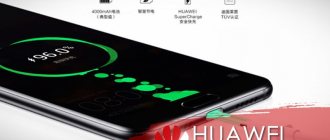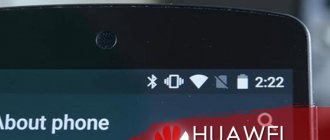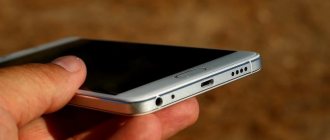Heating of the phone is a common phenomenon, which is typical not only for old but also for new devices. There may be many reasons for this, but this process is not always a problem that needs to be solved. If your phone gets too hot to use, you should turn off all applications and put the device aside. And when it cools down, try to find out the reason.
In all other cases, slight heating of the smartphone body is normal. The phone heats up when the display brightness is increased, games are turned on, or wireless networks are used for a long time. Almost any action you take with your phone will remove heat from the processor through the back cover, causing it to start to get a little warm. But this does not mean at all that you need to reduce the brightness to a minimum, stop playing games and using the Internet. This is part of the workflow, so you don't have to worry about slight heat build-up.
You need to worry in other cases:
- The phone heats up quickly even when you are not using it.
- It gets hotter than usual while charging.
- Only certain parts of the device overheat.
- Heat causes freezing or shutdown.
In these situations, the phone cannot be used at all. And you need to determine the cause as quickly as possible in order to minimize losses. Let's look at the most likely reasons right now.
Phone heating up
Unoptimized applications
Some applications and games for smartphones may be poorly optimized for specific systems or simply written on the knee. All this leads to the fact that they misuse the phone's resources, causing it to quickly heat up. Do not download unverified applications not only from third-party sources, but also from the Play Market.
Unoptimized applications on your phone
Possible causes and solutions
As you know, electrical appliances overheat when used for a long time. This is primarily due to the fact that they use electric current to operate. Therefore, this is what happens during use. But sometimes the device overheats more than usual. And the temperature rises above the permissible value, as a result of which the device begins to malfunction.
There are several reasons why an Android phone gets hot:
- Tasks are running that consume large amounts of electrical energy. You need to stop performing these tasks.
- Malfunction of the gadget itself. The breakdown needs to be fixed.
- Normal heating resulting from the operation of an electrical appliance. If the gadget is too susceptible to this, then you need to leave it alone for a while.
Powerful games and applications
Constantly rendering multiple 3D models and textures in games or executing unoptimized program code is a difficult task for the processor, causing it to heat up to 50-60 ºС. This temperature is normal for this component of the phone, but harmful for other elements.
The solution is to take breaks in the game for 10 minutes every 40-50 minutes, while turning off the application and turning off the screen. If possible, point a fan at the phone to speed up cooling.
Watch video
Playing video in high quality is a resource-intensive task that heats the processor to the same temperatures as games. But in the case of movies, there is no need to constantly hold the phone in your hands, additionally heating it. It is enough to install it on a stand or lean it on a glass or wall. This will allow the air to draw heat from the screen and back cover, cooling the device.
Background processes
Background processes are messengers, widgets and other applications that are not displayed on the screen, but at any time can detect their presence in RAM with a notification in the notification line. You can disable them by forcefully stopping the application and turning off notifications. In games, for example.
For Android the procedure is as follows:
- Open “Settings” => “Applications”.
- Open a list of running programs.
- Select the one you don’t need and click “Stop”.
Maximum screen brightness
The display matrix, operating for several hours in a row at maximum brightness, also contributes to the overall temperature of the device by heating the battery. To reduce the temperature, just move the brightness slider to the middle of the strip that adjusts this parameter on the notifications and quick settings screen, called up by swiping down from the top edge of the screen.
Wireless interfaces
Wireless interfaces should be understood as all methods of connecting a smartphone with other devices: mobile communications and the Internet, Wi-Fi, GPS, Bluetooth, NFC. Running these technologies at the same time without a device to connect to wastes battery power and increases the temperature of the smartphone.
Wi-Fi, GPS, Bluetooth buttons
The gadget heats up the most when the GPS is turned on and the navigator application is running. Therefore, it is recommended to use them intermittently and only to check that the route is being followed correctly.
But if conditions allow for improved cooling, for example, the smartphone is mounted on the handlebars of a bicycle and the back cover in the camera area is freely blown, then you don’t have to turn off the navigator and GPS. In a car, it is best to mount it on the grille of the ventilation system in the center of the instrument panel and turn on the air conditioner or fan.
Using a smartphone while charging it
At one time, push-button phones could be safely used while they were being recharged. But modern smartphones receive very high voltage current from the charger. And if you are talking on your smartphone at this moment, then the heating processor will add to this. As a result, serious overheating may occur. And in rare cases, this leads to swelling of the battery and even fire.
Never talk on the phone while it is charging - after all, disconnecting it from the charger is not difficult. But you can open the browser and perform other simple actions.
Wrong charger
If your phone takes too long to charge or gets unnaturally hot while charging, you may be using the wrong adapter. Because of it, the battery can fail, and with it all other elements. Some also claim that smartphones overheat due to being left on charge overnight, but this is nothing more than a myth. All modern mobile devices are equipped with a system that stops the energy supply when it reaches 100%. You can find out more about how to properly charge your smartphone in our other article here.
Wrong charger
Which heating is considered normal and which is considered a malfunction?
A working smartphone may become hotter than usual in the following cases:
- The screen lasts a long time, especially at high brightness levels. For example, while watching a movie or surfing the Internet.
- A resource-intensive application is running - a game, a graphics editor, etc.
- The device is located near a heat source or exposed to sunlight.
- The device is searching for a cellular operator's network or in unstable connection conditions.
- The metal back cover of the phone serves as a heatsink - it removes heat from the processor. The processor cools normally, but the hot lid gives the user a subjective feeling of overheating.
Normally, the phone heats up almost evenly. Heat is concentrated in the processor area and distributed across the screen and back cover. It functions as usual, under significant load - with minor lags. When you stop using your phone and move it away from heat sources, it cools down to room temperature or remains lukewarm.
There is an opinion that the more productive a smartphone is, the more it heats up during operation. This is not so: there are very powerful devices that remain relatively cold under any load, but there are weak ones that “get red hot” only when talking on a mobile phone. It’s all about a successful or unsuccessful design solution, as well as the use of microcircuits with high or low heat production in the device platform.
By the way, sometimes the overheating of a mobile gadget cannot be determined by touch. This is indicated only by indirect signs - freezes and reboots when running resource-intensive applications, messages about high processor temperatures from monitoring tools (if installed) and other problems.
The following symptoms indicate an abnormal condition of the device:
- The gadget continues to heat up in standby mode or even after turning off. The battery drains faster.
- Heat concentrates in unusual places - near the camera, the power socket, in one part of the screen (not in the processor projection), especially if in this area the screen responds poorly to touch or otherwise behaves incorrectly.
- When the device gets hot, it slows down a lot, freezes, turns off, or reboots. Certain functions may fail (for example, wheezing appears in the speakers, the microphone or part of the screen stops working) or artifacts may appear on the screen.
- The strongest heating is observed while charging the phone. The charger is also noticeably hot.
- The battery gets hot during charging. The battery capacity is significantly reduced compared to the original. The back cover of the phone is raised or bent, and there is a pressure mark on the screen from the inside (the battery is swollen).
Next, we’ll figure out why these situations arise and what to do.
Clutter
This happens very rarely, but this possibility cannot be ruled out either. If you often install and uninstall many applications, your phone will end up with a lot of different garbage that needs to be cleaned up from time to time. If you don't do this, programs will begin to crash, run slower, causing more load on the processor, and possibly overheating.
Clutter
How to cool down your phone?
- Remove the cover, if equipped. It can trap heat.
- Turn on airplane mode to stop cellular, internet, GPS, and Bluetooth data transmitters from working and putting a strain on your processor.
- If the phone is not hot, then you can try putting it on something cool, but not in the refrigerator, so as not to create a sharp temperature difference, because it will only do harm.
- Use power saving mode and reduce brightness. This will make the work easier not only for the display, but also for the processor, as a result of which the phone will heat up less.
- Download apps you don't use. The phone will work faster, there will be more memory, and the processor will slow down and the phone will stop heating up.
- Install an application to clean your phone of unnecessary programs. You don't have to delete all files and programs manually; we know how lazy it can be to do this. Phone cleaning apps show how much memory is occupied and by which applications, show those that slow down the phone and remove everything unnecessary.
- Restart your phone . This advice is relevant if problems with smartphone overheating are related to software. Sometimes a simple reboot or reset to basic settings helps get rid of unnecessary programs and errors that load the processor.
Take care of your gadget, use its capabilities wisely, install a high-quality antivirus and the question “why is the phone heating up” will never bother you again.
You can upgrade your phone in the 100 Friends online store
. We have a huge range of accessories and spare parts for smartphones and tablets. Choose exactly what you need!
Main reasons for iPhone overheating
We recommend that you look through the full list and exclude reasons according to the list, so that by the end of reading this material you will already know exactly why your iPhone is heating up and how to resolve this situation.
Long-term use of the device
Yes, we are describing too obvious things, but in most cases, prolonged use of the device is the reason for the smartphone to overheat. As a rule, this can be associated with many things: accessing the Internet and watching videos, downloading and updating applications, playing games for a long time, using Wi-Fi, modem mode and many other “interesting” features of the device.
Solution:
- Close all applications that you currently have open;
- Disable all wireless networks: Wi-Fi, Bluetooth, including 3G, 4G Internet;
- Disable all background updates and downloads, synchronization, if such actions are currently being performed.
iOS firmware
The software also does not always work correctly, so various failures may occur, resulting in an increase in the temperature of the device. As a rule, most often this happens as a result of a Jailbreak, and not the most successful one.
Solution:
In this case, you will have to roll back iOS to the latest stable version and see what's wrong. This applies to both devices that have been updated to a certain version, as well as those that have been jailbroken. In fact, there may be hundreds of reasons, but, as a rule, in this case they occur only for a small number of users.
Almost all stable versions of iOS work correctly and do not cause such symptoms. Yes, there were cases when it was a “jamb” of Apple developers, but such situations were resolved extremely quickly with a separate system update.
Battery fault
If you have been using your smartphone for a long time, the reason for the battery heating may be its expiration date. After all, over time, the capacity runs out, and despite the fact that the system says, for example, 100% charge, in fact it is 90 or 80%, and after the next charge it begins to heat up. This can happen either due to frequent recharging, or simply due to other problems associated with a battery malfunction.
Solution:
It is quite difficult to determine the exact cause of the malfunction, so in this case you need to take the smartphone to a service center, where they will carry out a thorough diagnosis, and if the problem is really in the battery, it will need to be replaced. We only recommend ordering original batteries, otherwise you may encounter a lot more problems!
Moisture in the phone
Has your smartphone fallen into water? Thought you had dried it out, but the battery was seriously heating up? In fact, moisture getting inside the iPhone can already be 80% the cause of such an event. Moreover, this is typical for almost all models, even those protected by IP67 standards.











